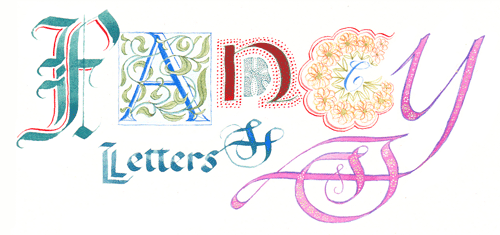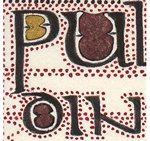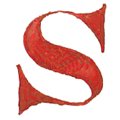Fancy lettering and calligraphy
Fancy lettering is found wherever people want striking and beautiful written words: on shop signs, greetings cards, website titles, wine labels, bookplates, hoardings, posters, café windows and a hundred other places where the eye might rest ...

'Lettering' is a huge subject, of which 'fancy lettering' forms a large part. It's not exactly the same as calligraphy, but the two subjects do overlap a great deal. Being able to create all kinds of decorative letter is certainly a useful calligraphy skill.

Whether you are already a keen calligrapher or you're looking for ready-to-go alphabet letters, do apply your calligraphy skills towards an imaginative, clever use of lettering – even if it's just to look at a set of letters with a calligraphically critical eye to see how they or their decoration might be bettered.
After all, calligraphy alphabets have evolved over time into well- proportioned aesthetic forms which are instantly recognisable as beautiful even for someone who can't read. They readily lend themselves to further decoration and beautification but they can be taken over-the-top too! Signwriters, typographers, font designers and other lettering professionals take an interest in calligraphy partly because it expands their repertoire for fancy alphabets as well as helping them to evolve highly legible 'plain' writing.
It's possible to draw very elaborately beautiful letters using just a calligraphy pen or brush, and one plain colour.
By using a fine marker or adding a little contrasting colour, your fancy lettering gains detail and impact.
And you can achieve even more elaborately impressive effects using other skills associated with calligraphy, such as vine-patterning, gold-leafing, miniature-painting etc.
Gothic is a decorative alphabet I'm particularly fond of, and I've created a couple of other pages showing step-by-step examples of Gothic for a Happy Birthday greeting and also a Gothic doodling make-your-own-card exercise.
Hand-drawn fancy letters

Saying that, much decorative lettering doesn't involve using a broad-nibbed calligraphy pen at all. Many traditional alphabets were decorated by hand-outlining each capital letter and then colouring them in, often using vermilion red. These were the original 'rubricated' letters or 'versals'. They are curvy, energetic-looking letters that add a sense of cheerfulness to any piece of writing.
Another style of fancy lettering is 3D lettering such as balloon and bubble letters. I've included several pages about these fun alphabets on the site, including a tutorial on how to draw bubble letters in my own style.
Similarly, many of the foliage-entwined, dignified drop caps now found in free online resources are based on Victorian hand-drawn capitals ... which were themselves based on medieval or Renaissance originals created in outline using a very thin nib or paintbrush and then filled in using brush and colour. (For example, see the 'A' in the word 'FANCY' at the top of the page.)
Another example of hand-drawn decorative alphabets we all recognise are the 'A is for apple, 'B is for bee' posters which used to adorn the primary school walls. Each letter was decorated with a jolly picture of something beginning with that letter. It's still fun as an adult to devise alphabets, albeit perhaps with more sophisticated illustrations ... "A is for axolotl, B is for Bering Straits" ...?
Machine-made lettering
Fancy lettering is available for art and craft purposes as rub-on letters, in different scripts, prepared with less or more colour or decoration. Designers are constantly coming up with new decorative fonts for downloading, too. And, of course, you can make your own digital lettering including various special effects using the tools in most word-processing or picture editing software.
Hand-printed lettering
Somewhere in between drawn lettering and machine-printing is the art of hand-printing your own fancy letters. Of course you can buy beautiful rubber stamps of all kinds now, and even design your own online, with the advantage of getting a very professional and reasonably-priced product. The disadvantage is that you are somewhat limited in the kinds of ink that you can use (though the choice and quality are improving all the time; you might want to check out some scrapbooking suppliers for rubber-stamp printing inks.)
The advantage of making your own stamps for printing fancy letters is that you can choose the type of paint or ink you use for both its visual effect and also its suitability for the receiving medium you're using (paper, card, fabric etc). Depending on what you use to make your stamp with -- rubber, foam, potato, woodblock, lino etc -- you can experiment with different effects to develop a unique 'house' printing style.
Craft lettering
Although I'm a great fan of using a broad nib, I'd be the last to tell you that calligraphy should only be decorated using pen and ink and traditional methods. Everything and anything could be used to adorn beautiful writing, from coloured paper cut-outs to embroidered fabric appliqué, fired clay and semi-precious jewels. Just make sure you are using high-quality materials which will last; imagine you might one day create an heirloom, or an object which future art historians could comment upon in monographs, or a collectors' item which in fifty years' time will fetch a ridiculously high price online.
So 'fancification' is an important subject for this website. Browse around: you'll find various free-to-use letters, along with tips and techniques for creating your own. You will also find links to good inexpensive suppliers for the specific tools, books, and materials which I've found useful for taking my lettering skills and inspiration further.
Return from 'Fancy Lettering' to the Calligraphy Skills homepage